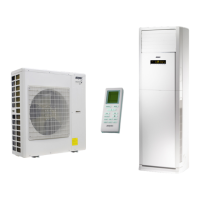17
No gap
10.6. NOTES FOR THE CONSTRUCTION
OF REFRIGERANT LINES
• When connecting the indoor unit to the connection pipe,
do not force the couplings on the indoor unit, as this
could cause cracks in the capillary pipes and other pipes
on the indoor unit, causing them to leak.
• The connection pipe must be supported by a suitable
bracket. The unit should not bear the weight of the pipe.
• To avoid leaks and the formation of condensate on the
connection pipes, these must be covered in thermal insu-
lation material bound with adhesive tape and insulated
from the air.
• The connection joint with the indoor unit must be wrapped
in thermal insulation. There must be no gaps between the
pipe connection and the wall of the indoor unit.
• After wrapping the pipes in protective material, they
should never be bent at an acute angle as this could
crack or break them.
• Use adhesive tape to cover the pipes:
− Use adhesive tape to bind together the connection pipes
and the cables. To prevent condensate flowing out of the
discharge pipe, separate the discharge pipe from the
connection pipe and cables.
− Use thermal insulating tape to bind together the pipes
from the bottom of the outdoor unit to the upper end of
the pipe where it enters the wall. When using insulating
tape, the final wrap should half cover the first wrap of
tape.
Gas pipe
External sheath
Condensate discharge
pipe
Insulation
Liquid pipe
Electrical cables
Insulation
IF THE OUTDOOR UNIT IS INSTALLED BELOW THE
INDOOR UNIT
• The condensate discharge pipe must be positioned above
ground level and the end section of the pipe must not be im-
mersed in water. All the pipes must be fixed to wall with brack-
ets.
• Wrap the pipes in tape from bottom to top.
• All the pipes must be bound together and wrapped in tape
and fixed to the wall with brackets.
• The hole in the wall must be sealed.
IF THE OUTDOOR UNIT IS INSTALLED ABOVE THE
INDOOR UNIT
• The pipe must be tilted and the end section of the pipe must
be lower than the indoor unit. The condensate discharge pipe
must be positioned above ground level and the end section of
the pipe must not be immersed in water. All the pipes must be
fixed to wall with brackets.
• Wrap the pipes in tape from bottom to top.
• All the pipes must be bound together and wrapped in tape
and fixed to the wall with brackets.
• The hole in the wall must be sealed.
WARNING
To connect the indoor unit to the refrigerant lines it is necessary to remove the plastic protective closure from the liquid/gas connections
and use the brass taper nuts supplied.
10.7. CONDENSATE DISCHARGE
• The condensate discharge hose can be
positioned on the left or right (removing
the relevant knockout from the casing) or
to the rear as previously indicated.
• The diameter of the condensate dis-
charge hose must be the same as - or
greater than - the diameter of the con-
nection pipe.
• Seal the connections and wrap with insu-
lating material to prevent the formation of
condensate on the external surfaces of
the pipe
• Keep the condensate discharge hose
short and tilt it downwards with a gradient
of at least 1:100.
• Do not bend the condensate discharge
hose.
• After connecting the hose, check that the
condensate water flows freely
• To check the drainage, pour water into
the condensate discharge tray.
• Check that the condensate water drains
correctly. The connection of the conden-
sate discharge hose must be leak-free

